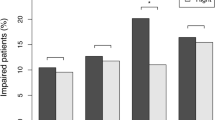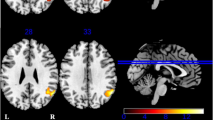Abstract
We addressed the neuroanatomical correlates of 54 right-brain-damaged neurosurgical patients on visuo-spatial design fluency, which is a measure of the ability to generate/plan a series of new abstract combinations in a flexible way. 22.2% of the patients were impaired. They failed the task because they did not use strategic behavior, in particular they used rotational strategy to a significantly lower extent and produced a significantly higher rate of perseverative errors. Overall performance did not correlate with neuropsychological tests, suggesting that proficient performance was independent of other cognitive domains. Performance significantly correlated with use of rotational strategy. Tasks related to executive functions such as psychomotor speed and capacity to shift were positively correlated to the number of strategies used to solve the task. Lesion analysis showed that the maximum density of the patients’ lesions—obtained by subtracting the overlap of lesions of spared patients from the overlap of lesions of impaired patients—overlaps with the precentral gyrus, rolandic operculum/insula, superior/middle temporal gyrus/hippocampus and, at subcortical level, with part of the superior longitudinal fasciculus, external capsule, retrolenticular part of the internal capsule and sagittal stratum (inferior longitudinal fasciculus and inferior fronto–occipital fasciculus). These areas are part of the fronto–parietal–temporal network known to be involved in top–down control of visuo-spatial attention, suggesting that the mechanisms and the strategies needed for proficient performance are essentially visuo-spatial in nature.



Similar content being viewed by others
References
Tucha O, Smely C, Preier M, Lange KW (2000) Cognitive deficits before treatment among patients with brain tumors. Neurosurg 47:324–334
Cattelani R, Dal Sasso F, Corsini D, Posteraro L (2011) The modified five-point test: normative data for a sample of Italian healthy adults aged 16–60. Neurol Sci 32:595–601
Regard M, Strauss E, Knapp P (1982) Children’s production on verbal and non-verbal fluency tasks. Percept Motor Skills 55:839–844
Jones-Gotman M, Milner B (1977) Design fluency: the invention of nonsense drawings after focal cortical lesions. Neuropsychologia 15:653–674
Ruff R (1996) Ruff figural fluency test. Test. Professional manual. In Psychological Assessment Resources
Lezak MD (2004) Neuropsychological assessment. Oxford University Press
Baldo JV, Shimamura AP, Delis DC, Kramer J, Kaplan E (2001) Verbal and design fluency in patients with frontal lobe lesions. J Int Neuropsychol Soc 7:586–596
Ruff RM, Evans R, Marshall LF (1986) Impaired verbal and figural fluency after head injury. Arch Clin Neuropsychol 1:87–101
Tucha O, Smely C, Lange KW (1999) Verbal and figural fluency in patients with mass lesions of the left or right frontal lobes. J Clin Exp Neuropsychol 21:229–236
Hassabis D, Maguire EA (2009) The construction system of the brain. Philos Trans R Soc Lond B Biol Sci 364:1263–1271
Tucha O, Smely C, Preier M, Lange KW (2000) Cognitive deficits before treatment among patients with brain tumors. Neurosurgery 47:324–334
Butler RW, Rorsman I, Hill JM, Tuma R (1993) The effects of frontal brain impairment on fluency: simple and complex paradigms. Neuropsychology 7:519–529
Robinson G, Shallice T, Bozzali M, Cipolotti L (2012) The differing roles of the frontal cortex in fluency tests. Brain 135(Pt 7):2202–2214
Elfgren C, Risberg J (1998) Lateralized blood flow increases during fluency tasks: influence of cognitive strategy. Neuropsychologia 36(6), 505–512
Suchy Y, Kraybill ML, Gidley Larson JC (2010) Understanding design fluency: motor and executive contributions. J Int Neuropsychol Soc 16:26–37
Wilson BA, Cockburn J, Halligan PW (1987) Behavioral inattention test (BIT). Thames Valley Test Company, London
Basso A, Capitani E, Laiacona M (1987) Raven’s coloured progressive matrices: normative values on 305 adult normal controls. Funct Neurol 2:189–194
Oldfield RC (1971) The assessment and analysis of handedness: The Edinburgh inventory. Neuropsychologia 9:97–113
Spinnler M, Tognoni G (1987) Standardizzazione e taratura italiana di test neuropsicologici. Ital J Neurol Sci 8:1–120
Monaco M, Costa A, Caltagirone C, Carlesimo GA (2015) Erratum to: forward and backward span for verbal and visuo-spatial data: standardization and normative data from an Italian adult population. Neurol Sci 36:345–347
Mondini S, Mapelli D, Vestri A, Arcara G, Bisiacchi PS (2011) Esame Neuropsicologico Breve 2. Raffaello Cortina Editore, Milan
Giovagnoli AR, Del Pesce M, Mascheroni S, Simoncelli M, Laiacona M, Capitani E (1996) Trail making test: normative values from 287 normal adult controls. Ital J Neurol Sci 17:305–309
Wechsler D (1997) Wechsler adult intelligence scale—Third edition (WAIS-III). Psychological Corporation, San Antonio
Goebel S, Fischer R, Ferstl R, Mehdorn HM (2009) Normative data and psychometric properties for qualitative and quantitative scoring criteria of the five-point test. Clin Neuropsychol 23:675–690
Tucha O, Smely C, Preier M, Lange KW (2016) Cognitive deficits before treatment among patients with brain tumors. Neurosurgery 47:324–334
Hopfinger JB, Buonocore MH, Mangun GR (2000) The neural mechanisms of top–down attentional control. Nat Neurosci 3:284–291
Karnath H-O, Berger MF, Küker W, Rorden C (2004) The anatomy of spatial neglect based on voxelwise statistical analysis: a study of 140 patients. Cereb Cortex 14:1164–1172
Doricchi F, Thiebaut de Schotten M, Tomaiuolo F, Bartolomeo P (2008) White matter (dis)connections and gray matter (dys)functions in visual neglect: gaining insights into the brain networks of spatial awareness. Cortex 44:983–995
Author information
Authors and Affiliations
Corresponding author
Electronic supplementary material
Below is the link to the electronic supplementary material.
Rights and permissions
About this article
Cite this article
Marin, D., Madotto, E., Fabbro, F. et al. Design fluency and neuroanatomical correlates in 54 neurosurgical patients with lesions to the right hemisphere. J Neurooncol 135, 141–150 (2017). https://doi.org/10.1007/s11060-017-2560-3
Received:
Accepted:
Published:
Issue Date:
DOI: https://doi.org/10.1007/s11060-017-2560-3




